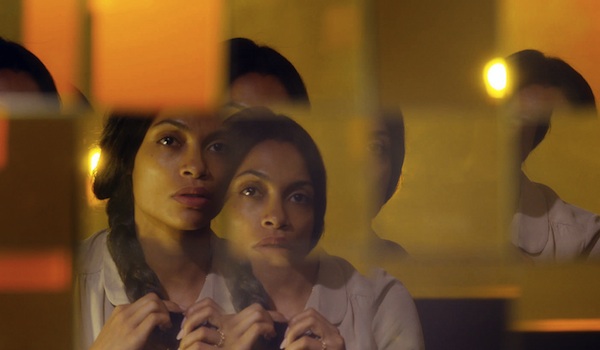Movie review by Greg Carlson
WARNING: The following review reveals key plot information. Read only if you have seen “Trance.”
The recently released “Oblivion” made the error of using Andrew Wyeth’s “Christina’s World” as an artificial stand-in for desired psychological depth that failed to materialize. In Danny Boyle’s “Trance,” a similar tactic is employed via Francisco Goya’s 1798 “Witches in the Air,” but in this case the painting is a major MacGuffin at the center of an auction house art heist gone wrong. Boyle pays homage to and explodes the contours of classic film noir, although one’s enjoyment of the movie will depend on the extent to which disbelief can be suspended in the service of a plot that explores lost and found memory.
James McAvoy, Rosario Dawson, and Vincent Cassel form the highly unreliable triangle of participants in the criminal roundelay. McAvoy’s Simon is the inside man who suffers an unexpected blow to the head that leaves crook Franck (Cassel) no choice but to retain the services of hypnotherapist Elizabeth Lamb (Dawson), who will assist Simon in remembering the location of the Goya. In his biography of Ava Gardner, Lee Server wrote that amnesia is “noir’s version of the common cold.” Joe Ahearne – who wrote and directed the TV movie upon which “Trance” is based – and John Hodge take the device to heart in their script, setting out to both construct a typically fatalistic noir and explore the abstract, faulty, and untrustworthy workings of the brain.
With its dependence on double and triple-crosses, “Trance” pays homage to a number of twisty noir hallmarks, including “Detour,” “D.O.A.,” and as Tom Wardak has pointed out, “High Wall” and “Spellbound,” a pair of psychiatry noirs that Wardak notes, “flipped the gendered stereotypes of male psychotherapist and female hysteric… to explore the emasculation that returning soldiers now felt in a peaceful, domesticated, female-driven arena.” The emasculation of “Trance” is mostly visual and in keeping with motion picture rating double standards, as both McAvoy and Cassel are photographed in careful compositions to obscure their genitalia while Dawson’s nudity is situated as a key plot point doubling as an art history lesson about the presence and absence of pubic hair.
Even though Lamb is grossly outnumbered by the male thugs and thieves with whom she capably holds her own, “Trance” has a few tricks up its sleeve regarding gender. While it is easy to read Lamb initially as a femme fatale responsible for the downfall of Simon, Boyle’s slippery shifts in allegiance and the revelation of Simon as a possessive abuser suggest that the “real” protagonist of “Trance” is Elizabeth. Unfortunately, Boyle seems to be less interested in character than in structure, and despite Dawson’s considerable efforts, Lamb suffers in the tradeoff.
The resolute amorality of the movie’s characters burdens anything that might pass for a rooting interest, and in this respect “Trance” is less successful than Boyle’s directorial debut “Shallow Grave.” Regular collaborator Anthony Dod Mantle works his usual magic behind the camera, fracturing, fragmenting, and mirroring motifs into a hallucinatory kaleidoscope that includes a bizarre close-up of what remains of Cassel’s head after a point blank gunshot. Next to Dawson’s glabrousness, it’s the movie’s most discussed image. The photographic pyrotechnics complement the contrivances bound to the film’s big shock, a disclosure made all the wilder for its dependence on Simon’s acomoclitism as memory trigger. “Trance” may not be for every taste, but it’s a razor in more ways than one.
